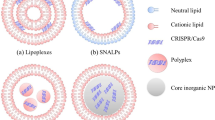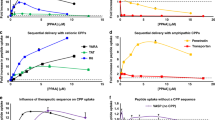Abstract
In this study, we developed a nonviral, cationic, targeted DNA–carrier system by coupling SAINT/DOPE lipids to monoclonal antibodies. The two monoclonal antibodies used were both tumor specific, that is, MOC31 recognizes the epithelial glycoprotein EGP-2 present in carcinomas and Herceptin recognizes the HER-2/neu protein in breast and ovarian cancers. Coupling was performed under nonreducing conditions by covalent attachment. The coupling procedure appeared to be reproducible and the binding capacity of the antibody was not affected by linking them to the cationic lipid. Binding and transfection efficiency was assayed with target cells and nontarget cells. SAINT/DOPE lipoplexes as such appeared to be an effective transfection reagent for various cell lines. After coupling SAINT/DOPE to the monoclonal antibodies or F(ab)2 fragments, it was shown that the targeted MoAb-SAINT/DOPE lipoplexes preferably bound to target cells, compared to binding to the nontarget cells, especially for the Herceptin-SAINT/DOPE lipoplexes. More importantly, transfection of the target cells could also be improved with these targeted lipoplexes. In conclusion, we have shown that by using monoclonal antibody-coupled SAINT/DOPE lipoplexes cells targeted gene delivery can be achieved, and also a higher number of transfected target cells was seen.
This is a preview of subscription content, access via your institution
Access options
Subscribe to this journal
Receive 12 print issues and online access
$259.00 per year
only $21.58 per issue
Buy this article
- Purchase on Springer Link
- Instant access to full article PDF
Prices may be subject to local taxes which are calculated during checkout




Similar content being viewed by others
References
Venter JC, Adams MD, Myers EW, et al., The sequence of the human genome. Science. 1995;291:1304–1351.
Miller AD . Retrovirus packaging cells. Human Gene Ther. 1990;1(1):5–14.
Mah C, Byrne BJ, Flotte TR . Virus-based gene delivery systems. Clin Pharmacokinet. 2002;41:901–911.
Schiedner G, Morral N, Parks RJ, et al. Genomic DNA transfer with a high-capacity adenovirus vector results in improved in vivo gene expression and decreased toxicity. Nat Genet. 1998;18:180–183.
Carter PJ, Samulski RJ . Adeno-associated viral vectors as gene delivery vehicles. Int J Mol Med. 2000;6:17–27.
Kay MA, Manno CS, Ragni MV . Evidence for gene transfer and expression of factor IX in haemophilia B patients treated with an AAV vector. Nat Genet. 2000;24:257–261.
Cristiano RJ . Protein/DNA polyplexes for gene therapy. Surg Oncol Clin N Am. 2002;11:697–716.
Dunlap DD, Maggi AS, Marco R, Monaco L . Nanoscopic structure of DNA condensed for gene delivery. Nucl Acid Res. 1997;25:3095–3101.
Ferkol T, Perales JC, Eckman, E, et al. Gene transfer into the airway epithelium of animals by targeting the polymeric immunogobulin receptor. J Clin Invest. 1995;95:493–502.
Nishikawa M, Yamauchi M, Morimoto K, Ishida E, et al. Hepatocyte-targeted in vivo gene expression by intravenous injection of plasmid DNA complexed with synthetic multi-functional gene delivery system. Gene therapy. 2000;7:548–555.
Kircheis R, Kichler A, Wallner G, et al. Coupling of cell-binding ligands to polyethylenimine for targeted gene delivery. Gene Therapy. 1997;4:409–418.
Li S, Rizzo MA, Bhattacharaya S, Huang L . Characterization of cationic lipid-protamine-DNA (LPD) complexes for intravenous gene delivery. Gene Therapy. 1998;5:930–937.
Felgner PL, Gadek TR, Holm M, Roman R, et al. Lipofection: a highly efficient, lipid mediated DNA transfection procedure. Proc Natl Acad Sci USA. 1987;84:7413–7417.
Smyth Templeton N, Lasic DD, Frederik PM, et al. Improved DNA: liposome complexes for increased systemic delivery and gene expression. Nat Biotechnol. 1997;15:647–652.
Liu Y, Thor A, Shtivelman E, et al. Systemic gene delivery expands the repertoire of effective antiangiogenic agents. J Biol Chem. 1999;274:13338–13344.
Vd Woude I, Wagenaar A, Meekel AP, et al. Novel pyridinium surfactants for efficient, nontoxic in vitro gene delivery. Proc Natl Acad Sci. 1997;94:1160–1165.
Audouy S, Molema G, de Leij L, Hoekstra D . Serum as a modulator of lipoplex-mediated gene transfection: dependance of amphiphile, cell type and complex stability. J Gene Med. 2000;2:465–476.
Zuhorn IS, Oberle V, Visser W, Engberts JBFN, Bakowsky U, Hoekstra D . The phase behavior of cationic amphiphiles and their mixtures with helper lipid influences lipoplex shape, DNA translocation, and transfection efficiency. Biophys J. 2002;83(4):2096–2108.
Li S, Tan Y, Viroonchatapan E, et al. Targeted gene delivery to pulmonary endothelium by anti-PECAM antibody. Am J Physiol Lung Cell Mol Phys. 2000;278:504–511.
Spragg DD, Alford DR, Greferath R, et al. Immunotargeting of liposomes to activated vascular endothelial cells: a strategy for site-selective delivery in the cardiovascular system. Proc Natl Acad Sci USA. 1997;94:8795–8800.
Mastrobattista E, Kapel RHG, Eggenhuisen MH, et al. Lipid-coated polyplexes for targeted gene delivery to ovarian carcinoma cells. Cancer Gene Ther. 2001;8(6):405–413.
Xu L, Tang W-H, Huang C-C, et al. Systemic p53 gene therapy of cancer with immunolipoplexes targeted by anti-transferrin receptor scFv. Mol Med. 2001;7(10):723–734.
Balzar M, Winter MJ, de Boer CJ, Litvinov S . The biology of the 17-1A antigen (Ep-CAM). J Mol Med. 1999;77:699–712.
Herlyn M, Steplewski Z, Herlyn D, Koprowski H . Colorectal carcinoma-specific antigen: detection by means of monoclonal antibodies. Proc Natl Acad Sci USA. 1979;76:1438–1452.
Semba K, Kamata N, Toyoshima K, Yamamoto T . A v-erbB-related protooncogene, c-erbB2, is distinct from the c-erb-1/epidermal growth factor-receptor gene and is amplified in a human salivary gland adenocarcinoma. Proc Natl Acad Sci USA. 1985;82:6497.
Carter P, Presta L, Gorman C, et al. Humanization of an anti-p185HER2 antibody for human cancer therapy. Proc Natl Acad Sci USA. 1992;89:4285–4290.
Sliwkowski MX, Lofgren JA, Lewis GD, Hotaling TE, Fendly BM, Fox JA . Nonclinical studies addressing the mechanism of action of Trastuzumab (Herceptin). Seminars in Oncol. 1999;26(4):60–70.
Mariani M, Camagna M, Tarditi L, Seccamini E . A new anzymatic method to obtain high yield F(ab)2 suitable for clinical use from mouse IgG1. Mol Immunol. 1991;28(1/2):69–77.
De Jonge MW, Kosterink JGW, Bin YY, et al. Radioimmunodetection of human small cell lung carcinoma xenografts in the nude rat using 111 in-labelled monoclonal antibody MOC31. Eur J Cancer. 1993;29A(13):1885–1890.
Ross PC, Hui HW . Lipoplex size is a major determinant of in vitro lipofection efficiency. Gene Therapy. 1999;6:651–659.
Audouy S, Hoekstra D, de Leij L, Hospers G, Molema G . Behaviour of SAINT lipoplexes after intravenous administration: safety and biodistribution in mice. Thesis, Cationic liposomes as DNA delivery system. 2002; Chapter 5, p. 87–101.
Acknowledgements
This research was supported by a STIGON grant from the Netherlands Organization for Scientific Research (ZON-MW). We thank Dr JAAM Kamps (Dept of Cell Biology, section Liposome Research, Groningen University Institute for Drug Exploration) for particle size measurements.
Author information
Authors and Affiliations
Corresponding author
Rights and permissions
About this article
Cite this article
Zanten, J., Meer, Bv., Audouy, S. et al. A nonviral carrier for targeted gene delivery to tumor cells. Cancer Gene Ther 11, 156–164 (2004). https://doi.org/10.1038/sj.cgt.7700668
Received:
Published:
Issue Date:
DOI: https://doi.org/10.1038/sj.cgt.7700668
Keywords
This article is cited by
-
Gene therapy for hepatocellular carcinoma using sonoporation enhanced by contrast agents
Cancer Gene Therapy (2005)



